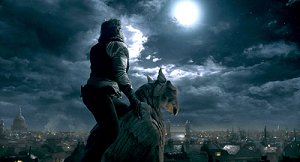 |
|
At The Picture Show
|
March 2010
The quotidian full moon; or, how to take storytelling shortcuts
'The Wolfman' returns to find himself inside a confused, nonsensical story

The Wolfman
Universal Pictures
Director: Joe Johnston
Screenplay: Andrew Kevin Walker and David Self, based on a 1941 screenplay by Curt
Siodmak
Starring: Benicio Del Toro, Anthony Hopkins, Emily Blunt, Hugo Weaving, Art Malik and
Geraldine Chaplin
Rated R / 1 hour, 42 minutes

 (out of four)
(out of four)
If you knew nothing of lunar phases and you happened to see The Wolfman, you might assume
that full moons happened just about every night. And let's be honest - that would be much more
convenient for the werewolf, would it not? I mean, if a full moon only comes along every 30
days, what fun is that? Only twelve days a year to unleash a grand display of unspeakable
carnage and slaughter on an unsuspecting public?
Or maybe, you think to yourself, you're reading it all wrong. Maybe it's not that full moons are
part of our daily routine - no, it's just that they come along only when it is most convenient for
Wolfmen. The four weeks in between? Bah, we'll just ignore those. Details, who needs 'em!
 So it goes in The Wolfman, the long-gestating reboot of the
classic horror franchise. Little care is taken to establish any sense of consistency in the
storytelling; all that seemed to matter to the filmmakers was getting to the climaxes as soon as
possible, regardless of the film's own established internal logic.
So it goes in The Wolfman, the long-gestating reboot of the
classic horror franchise. Little care is taken to establish any sense of consistency in the
storytelling; all that seemed to matter to the filmmakers was getting to the climaxes as soon as
possible, regardless of the film's own established internal logic.
Full moons pop up in a seemingly impossible sequence. The Wolfman escapes from the
authorities' collective grasp one night and wreaks a bit of havoc - and in the next act, there he is,
turning into a werewolf again. In all this time - what seems like a day or two, but which
apparently has been a month, what with another full moon and all - no one has been able to
locate the Wolfman, even though they know his identity and know exactly where he lives. (And
if he's not a werewolf for four weeks - or at all during daylight - then wouldn't he be pretty easy
to find? Sheesh.) The progression from one sequence of events to the next is so haphazard that it
plays out as though only a matter of days or even hours has passed - and then suddenly another
full moon appears. Morphin' time!
You feel as if you've fallen asleep in the theatre and surely must have missed the last 15 minutes
or so. But you haven't. The filmmakers just hope you don't notice that, well, they haven't given
you any reason to believe a month has passed already. Since, you know, from one full moon to
the next, nothing has happened and nothing has changed.
 Then again, it's only fitting that The Wolfman can't rationalize
its timeline. The entire film is confused about its own narrative intentions. Now, we know the
set-up, don't we? Our hero, Lawrence (Benicio del Toro), returns home after many years away.
Bitten by the beast. Curses, chaos, carnage, all that. But the powers that be in this English
countryside - including a visiting inspector from Scotland Yard (Hugo Weaving) - not only
quickly determine Lawrence's plight, but see the results firsthand. Upon the first of many full
moons, the Wolfman attacks, ripping people to shreds in an impressively graphic bloodbath. Let
me make this clear: The Wolfman's presence and true identity are made unequivocally clear to
all the important parties.
Then again, it's only fitting that The Wolfman can't rationalize
its timeline. The entire film is confused about its own narrative intentions. Now, we know the
set-up, don't we? Our hero, Lawrence (Benicio del Toro), returns home after many years away.
Bitten by the beast. Curses, chaos, carnage, all that. But the powers that be in this English
countryside - including a visiting inspector from Scotland Yard (Hugo Weaving) - not only
quickly determine Lawrence's plight, but see the results firsthand. Upon the first of many full
moons, the Wolfman attacks, ripping people to shreds in an impressively graphic bloodbath. Let
me make this clear: The Wolfman's presence and true identity are made unequivocally clear to
all the important parties.
And yet, after Lawrence - back in human form, of course - is arrested the following morning,
the film takes an abrupt and illogical left turn. (In fact, I wouldn't even call it a left turn - more
like the movie sticks it in reverse and starts doing donuts in the parking lot.) Lawrence is taken
to a mental hospital, where the doctors - under the authority of the police and government -
insist that he is not a werewolf. They tell him it's all in his head. They tell him werewolves
don't exist, and that he is not the Wolfman.
This despite the fact that everyone has just seen him turn into a werewolf and kill people.
Everyone knows he is a werewolf. It's been established. Everyone saw it. THAT'S WHY HE
WAS ARRESTED!
This plot sequence in the hospital doesn't do anything for the audience - we're just biding our
time until the beast's next appearance. And it makes absolutely no sense for the authority
figures in charge of Lawrence at the hospital - their insistence that he is not a werewolf only
serves to contradict the logic of the preceding scenes.
 When he is tied up and put on display in an observation room
one night - the doctor's stated intention being to prove that Lawrence will not turn into a
werewolf when the moon comes out - everyone acts shocked and appalled when the
transformation indeed does come about. Even though - and I can't state this clearly enough -
everyone already knows (or at least should know) that he's a werewolf.
When he is tied up and put on display in an observation room
one night - the doctor's stated intention being to prove that Lawrence will not turn into a
werewolf when the moon comes out - everyone acts shocked and appalled when the
transformation indeed does come about. Even though - and I can't state this clearly enough -
everyone already knows (or at least should know) that he's a werewolf.
It's as if two differing approaches to the story were being considered - one in which there was
some uncertainty or ambiguity on the characters' part as to whether or not Lawrence was a
werewolf, and one in which there was no uncertainty. And both ideas somehow made it into the
same shooting script.
The idiocy of the narrative is a shame, really - since it detracts from the film's strength's, not the
least of which is a finely realized Gothic aesthetic, both in mood and visuals. Additionally, Del
Toro was a strong choice for the lead role - he practically doesn't even need makeup to appear
wolflike and ominous. And as for his animal incarnation, I must say it's a pleasure to see
honest-to-goodness, physical makeup work used to create the Wolfman himself. After seeing the
dreadful CGI werewolves in last year's New Moon, it's a relief to see a plausible version this
time around.
Read more by Chris Bellamy